
http://dx.doi.org/10.13092/lo.69.1657
Linguistic politeness is one of the most immediate reflections of socio-cultural reality in language. That is why it is promising to investigate manifestations of linguistic politeness in countries that are experiencing major social transformations. Serbia, which has undergone enormous political and economic changes during the last 25 years, is such an interesting object of investigation for politeness research. In the empirical study presented here, 1 the politeness devices of a transformational society such as the Serbian one have been compared to those of a firmly established Western European culture, namely, linguistic politeness in Western Germany.2
Due to the fact that no comparative and empirical studies on the linguistic politeness of the two languages are available, 3 the first aim of the study was to detect and describe differences in linguistic politeness between Serbian and German. Where systematic differences between the politeness strategies of the two languages were found, the second aim of the study was to explain these differences either socio-culturally or linguistically.
In order to establish default communicative strategies in default communicative situations, it is crucial to document authentic and natural speech situations. For this reason, the speech data analysed in this study were gathered by means of covert observation. The focus of interest was on minimal everyday interactions such as service encounters, giving directions, greetings, and the like. Sometimes it was possible to record the interactions digitally, but in most cases verbatim records had to be made immediately after the speech event. This was possible because most of the interactions were very short, sometimes comprising only one formula of address or greeting. The data gathering took place from autumn 2005 to spring 2007 in Belgrade (Serbia) and in Mannheim and its surroundings (Germany). The Serbian corpus (henceforth SC) contains 162 oral speech events and 24 written documents consisting of 952 tokens4 altogether. The German reference corpus (henceforth GC) includes 709 tokens containing 60 oral speech events and four written documents.5 The tertium comparationis of the oral data is the exchange of goods in the broader sense of the word. Naturally, service encounters are the most immediate instantiations of such an exchange situation. Direction giving and even greetings can be interpreted as an exchange of immaterial values such as information or deference. The written data documents mainly address forms, as seen for instance on signs or in instruction leaflets. As regards the oral data, it is important to point out that the data were gathered exclusively by myself (labelled KS in the corpus data). As a result, the database is biased towards a higher representation of forms of address towards a female aged between twenty and thirty. It is also important here that the speech events gathered by means of participant observation were at risk of being flawed by my non-native competence of Serbian.
Although both data bases consist of comparable situations (marketplace interaction, other service encounters, direction giving and the like), the extra-linguistic contexts are not always identical. The sociological differences are most obvious in the marketplace situations. Serbian marketplaces offer products of a great variety (not only food) that are usually remarkably cheaper than in the supermarkets. In Germany, you find rather expensive food at marketplaces, which means that markets are frequented by middle class and upper middle class costumers, while Serbian marketplaces meet the needs of the middle, lower middle and lower classes. Thus, the sociological makeup of the customers may well have affected some of the findings. To counteract this bias, service encounters and other minimal interactions were also recorded in other locations such as supermarkets, shops, restaurants, cafes, university libraries and others. In this way, a socially more mixed range of interactions could be collected.
To compensate for the potential shortcomings of the corpora, a survey with native speakers of the two languages was conducted. The survey was designed to establish the native speakers' evaluations of politeness strategies and to find out more about their attitudes towards politeness and the values attached to it. 82 Serbs and 40 Germans participated in the study. The most important results of the survey will be discussed in Section 3.
The third pillar of the study forms an interview with a Serbian expert, a young Serbian female who spent a considerable period of time in Germany and other Western European countries. The aim of the interview was to challenge my necessarily German perspective on the data. In this paper, the findings of the interview appear sporadically and only to help corroborate or contest corpora or survey results.
Intercultural studies6 about linguistic politeness often come to the conclusion that solidarity cultures prevail in Southern and Eastern Europe while distance cultures7 are common in Western Europe. Solidarity cultures favour values such as solidarity, sincerity, familiarity and community; distance cultures hold self-determination, privacy, autonomy and the individual in higher esteem. As our study compares a western and a south-eastern European culture, the solidarity – distance typology will serve as a framework of critical analysis.
The focus will be on forms of address and requests, two kinds of speech acts which are generally important in linguistic politeness research. In the following sections the major results of the study will be presented and discussed in terms of the solidarity – distance typology.
The analyses are committed to a functional view on linguistic politeness as elaborated in Schlund (2009, 2014). The functional view assumes that the occurrence and make-up of a politeness device reflects the pragmatic and socio-cultural functions it fulfils. With regard to our twofold politeness typology, this means that politeness strategies will be analysed in view of their capacity to establish distance or solidarity oriented values.
Forms of address explicitly characterize the relationship between speaker and hearer. They function as indicators of social reality and change and are therefore often the subject of sociolinguistic analysis (cf. Jachnow 1974; Hartmann 1978; Keown 2003).
Most European languages dispose of a binary pronominal system of address which employs one pronoun for familiar address and another for formal address (cf. Helmbrecht 2005). Formal address is often marked by a plural in the second or third person. Familiar address is expressed by an ordinary second person pronoun in the singular. This distribution is well-founded, "for plurality is a very old and ubiquitous metaphor for power" (Brown/Gilman 1960: 255). Today, of course, forms of address in the plural indicate (mutual) respect or simply unfamiliarity rather than the asymmetric power relations which created such address forms in the first place.
Both Serbian and German feature a binary pronominal system. In Serbian, the two pronouns of address are ti (2. pers. sing.) and Vi (2. pers. plur.). German has a hybrid system that makes use of second and third person pronouns: familiar du (2. pers. sing.) and formal Sie (3. pers. plur.).8 As regards the historical development of the two systems, it is important to note that the German system is by far older than the Serbian one. First evidence of a German honorific Ihr (2. pers. plur.) dates back to the 9th century (cf. Helmbrecht 2005: 436–437; Schäfer 1951: 21; Simon 2003: 94). In the 17th century, third person honorifics were introduced (in both singular and plural) and three forms of formal address coexisted until honorific Sie eliminated the others. 9
In Serbian, like in most other South Slavic languages,10 formal address was introduced as late as in the 18th century (cf. Berger 1998: 317; Betsch 2007: 17)11 and only became commonly accepted in the 19th century (cf. Kocher 1967: 739).
Research on forms of address usually distinguishes between nominal and pronominal address. This dichotomy will serve our purposes for the analysis of Serbian and German speech data in the next two sections. In Section 2.3, a more sophisticated typology of address forms will be introduced which will integrate all of the attested forms of address in the two languages.
The Serbian forms of address attested in the corpus display a great variety and creativity. They can be classified as follows:
- Neutral forms:
gospođo 'Mrs-VOC'; gospođice 'Miss-VOC'; gospodine 'Mr-VOC'; komšinice '(female) neighbour-VOC'; komšija '(male) neighbour-VOC'; dečko 'boy-VOC'; devojko 'girl-VOC'
- Kinship terms:
sine 'son-VOC', ćerko 'daughter-VOC'
- terms of endearment:
dušo 'soul-VOC'; lutko 'doll-VOC'; lepotice 'beauty-VOC'; srećo 'luck-VOC'; pile 'chick-VOC''; srce 'heart-VOC''; milice 'dear-VOC'; mico 'darling-VOC'; zlato 'gold-VOC''; devojčice 'little girl-VOC'; curice 'little girl-VOC'; mala 'little one-VOC' (feminine)
Of course, the usage of all of these forms varies greatly in regard to the situation and participants of the communication. Kinship terms and terms of endearment occur most often in marketplace interaction and in other informal situations. They both semantically and discursively belong to the solidarity paradigm of politeness. Terms of endearment are mostly used by older women to address younger ones. Young men may employ the same terms of endearment to address young women, whereas older men seem to prefer kinship terms and diminutives, probably to avoid erotic connotations. It is important to note here that the use of solidarity nominal forms of address (kinship terms, terms of endearment) is often asymmetric, i. e., they are used by an older person towards a younger one but not vice versa. The formal and neutral terms are associated with the distance paradigm. They may be used in every speech situation in the SC but are most likely to occur in rather formal situations (for instance, in the university library).
In German, the variety in nominal address is by far poorer. In fact, nominal address in the GC does not imply nouns denoting persons but is almost completely restricted to the abstract nouns Entschuldigung/Verzeihung 'apology'/'forgiveness', or to the greeting formulae hallo/guten Tag 'hello' functioning as a form of address. Such kinds of nominal address can be attributed to the distance paradigm as they do not establish any kind of familiarity among the interactants. Forms of nominal address which are equivalent to Serbian ones are very rare (attested three times only) and occur exclusively in marketplace interactions:12
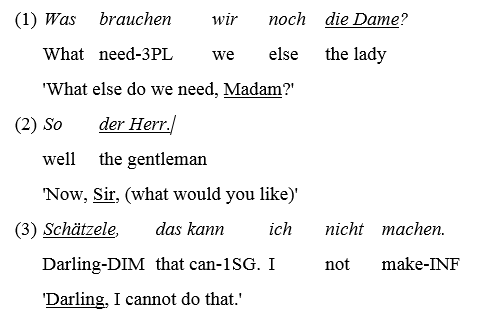
The address forms die Dame 'Madam' and der Herr 'Sir' are nowadays rather old-fashioned and reduced to informal and familiar situations, often endowed with a humorous note. They may also still occur in formal contexts (e. g. in luxurious restaurants or shops). German thus displays a considerable lacuna in personal nominal address. In contrast to Serbian, it is not common to address strangers by personal nouns such as Madam or Sir. This functional lacuna cannot be explained linguistically as there is no formal reason to not use these words as forms of address. The very existence of this lacuna in the address system of German can be explained more appropriately if we interpret it as a symptom of the cultural preference for the distance paradigm.
The address form Schätzele, a southern German diminutive of Schatz 'darling' can hardly be imagined outside the special setting of a marketplace (maybe in humorous utterances among friends or relatives). It is worth noticing that Schätzele is used by an old female marketplace-seller (aged between 70 and 80) towards a significantly younger female customer (aged between 20 and 30). Only this form of nominal address attested in the GC can be counted among forms of solidarity. It remarkably resembles the Serbian forms of solidarity in content and situational context in which it occurred.
However, there exists a semantic and functional (but not formal) equivalent to the most frequent German formula of address Entschuldigung orVerzeihung mentioned above. In Serbian, it is common to start an unexpected communication (as, for instance, a route direction dialogue) with izvini/izvinite (an imperative form with the literally meaning 'forgive'). However, when using this formula the speaker has to decide whether to use the T-form (izvini) or the V-form (izvinite) of address. It is impossible in Serbian to use bare nouns as nominal forms of address such as German Entschuldigung or Verzeihung. With Serbian izvini(te), we are entering the realm of pronominal address, which is the subject of the next section.
In the service encounters, the most frequent opening formula in Serbian is izvoli (2. Pers. Sing. Imp.) or izvolite (2. Pers. Plur. Imp.), a verbal phrase derived from the infinitive izvoliti. Izvoliti is a polysemic verb which usually occurs in the imperative. It either means something like what would you like or, at the end of a service encounter or another service rendered, it corresponds to here you are. The address forms izvoli and izvolite are highly idiomatic and there is no real communicative alternative to their usage. In our corpus, it is actually the only type of opening formula or closure attested in service encounters. It is important to note again that izvoli/izvolite involves a speaker's choice to either use the (familiar) T- or the (formal) V-form of address.
With the German equivalent for izvoli/izvolite, the adverbial phrase bitte schön,13 this is not the case. The speaker can use this formula without specifying their relationship towards the hearer as T or V.
While the use of T- and V-forms is stable and almost exclusively symmetric (i. e., the speaker and hearer both receive and give either T or V) in the GC, some cases of asymmetric usage occur in the SC. The interactions attested in the SC suggest that the asymmetric usage of the pronominal address is more likely in informal situations and among speakers with a great difference of age (between an older market-seller and a young costumer, for instance).
Furthermore, two cases of change from V to T have been attested in the SC. Both changes occur in interactions between KS and Serbian natives. The first situation is a service encounter on the marketplace between KS and a market-woman (MW) aged between 40 and 50:
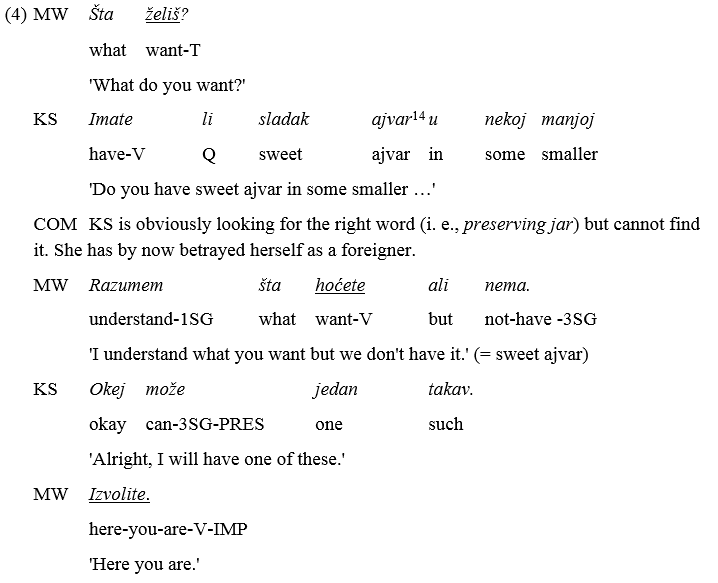
As expected, MW addresses the much younger KS with T in an informal context like the marketplace situation. However, having realized that KS is a foreigner, MW changes to V and sticks to it.
The second example of a change from T to V is even more striking because it happens with a taxi driver (TD) of about the same age as KS:
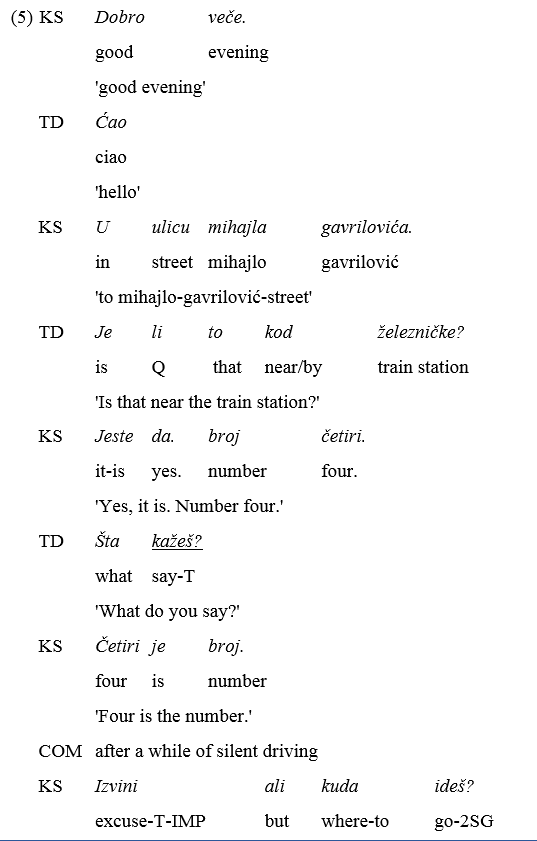
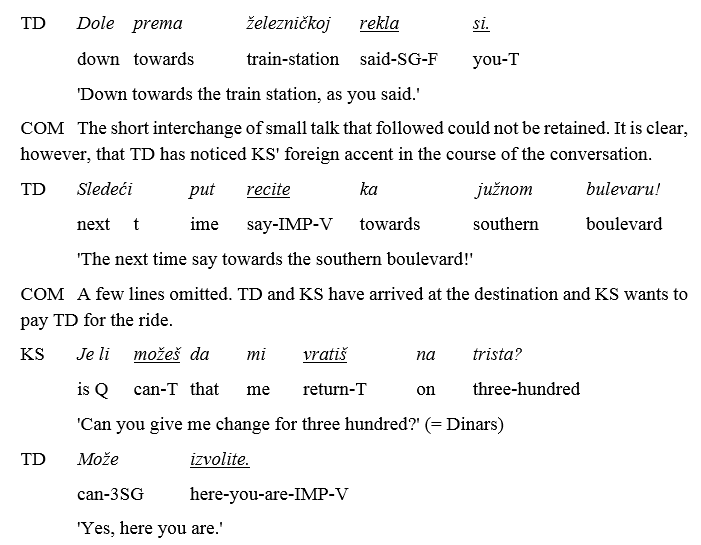
In both examples, it seems that the change from T to V takes place when the native speakers realize that KS is not a native speaker, which means that she is not a member of the speakers' ingroup. In the second case, the taxi driver insists on V although KS deliberately sticks to T after the driver's switch to V. Although these findings can claim only exemplary status, they are in line with Kocher's (1967: 737) statement that "[f]oreigners are usually kept in a V-V relationship."
In some cases, combinations of formal pronominal and informal nominal address and vice versa could be attested. Such kinds of "hybrid address" occurred twice in the SC:
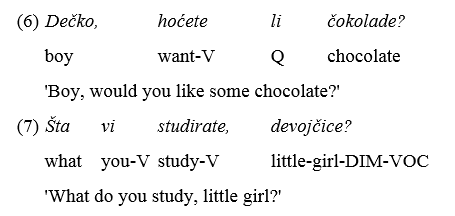
In (6) and (7), an informal nominal address form is combined with the formal pronominal V-address. Both are uttered by an older person towards a greatly younger one of the opposite sex. (6) took place on a coach-trip from Germany to Serbia. It could be that the hybrid nature of address is due here to a mixing of German and Serbian norms. In German, one would expect mutual V in interactions among mutually unknown adults, usually regardless of their age difference. In (7), it could be that V is used because the speaker knows that his addressee (KS) is a foreigner. He may nevertheless want to add a note of familiarity to the situation by using the term devojčica, which is clearly non-distant.
Two cases of inclusive address (i. e., mi – 'we', henceforth N-form)15 were recorded. N-address is a clear solidarity marker. In both cases, it is uttered by marketplace sellers and combined with a diminutive noun:
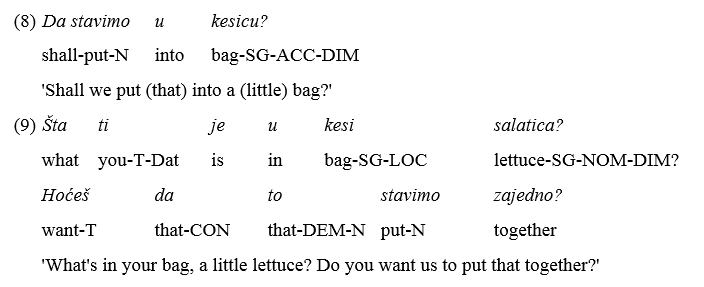
The significance of diminutive forms as a strategy of politeness of solidarity has often been emphasized in linguistic politeness research (cf. Antonopoulou/Sifianou 2005; Sifianou 1992: 69–73 for Greek; Brehmer 2006; Rathmayr 1996b: 371 for Russian; Wierzbicka 1985: 167–170 for Polish; Mendoza 2005 for Spanish). Although morphological diminutives exist in German as well (e. g. Büchlein – 'little book'; Täschchen – 'little bag'), they are not usually associated with politeness.
However, inclusive N-address occurred in the GC, too. Similar to the Serbian examples of N-address, the German ones were restricted to marketplace communication and uttered by marketplace sellers addressing their customers:
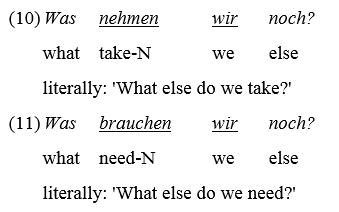
It is important to note here that the Serbian examples of inclusive N-address denote actions which are to be undertaken by the speaker, while the German incidents of N-address denote a future action of the addressee.16 Serbian N-address thus replaces speaker orientation, German N-address hearer orientation of an utterance.17 However, N-address occurred too rarely in the data to determine whether this difference is systematic.
In German, there exists another form of address that could not be attested in the SC. It is common in German to address people indirectly by using mere infinitives, so-called deontic infinitives (cf. Deppermann 2007):

Deontic infinitives typically replace imperatives that threaten the negative face of the addressee.18 That is why they range among the devices of negative politeness (in the sense of Brown/Levinson 1978, 1987) or, as labelled here, of politeness of distance.
In Serbian, deontic infinitives are not part of the standard language. This is at least partly due to the fact that Serbian belongs to the Balkan Sprachbund (cf. Mišeska Tomić 2006; Trubeckoj 1931), in which the infinitive either does not exist at all (modern Greek, Bulgarian, Macedonian, Albanian) or is at least restricted in usage (Serbian, Romanian). Surprisingly enough, some instances of written deontic infinitives are attested in the SC:
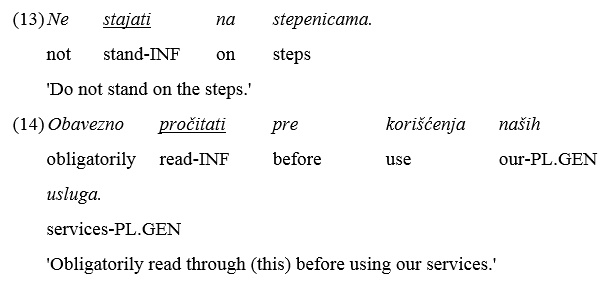
In 1967, Kocher (1967: 737) stated that the T-form was the only form used in written public orders in Serbian. This is obviously not the case anymore. In addition to the only rarely attested deontic infinitives, the V-form seems to be gaining ground against the still widely spread T-form on signs and other public orders. It is also interesting to note here that V-forms and deontic infinitives are more likely to occur in "new places", e. g. on signs on new busses or in restaurants of international fast-food-chains, while the old T-form is more often found in "old places" such as old busses, local authorities or universities (cf. Schlund 2009: 85–86).
The recent spreading of deontic infinitives and V-address is a clear development towards a politeness system of more distance.
The above analysis shows that the distinction between nominal and pronominal address is not sufficient to describe the relevant differences in the forms of address attested in the two corpora. That is why a more sophisticated description is introduced here. It starts from the question of whether the form of address displays any characterisation of the addressee. If it does not, the form of address will belong to the indeterminate or zero forms of address. Among those, one can distinguish between nominal, adverbial, and verbal forms of zero address, as illustrated below:

Table 1: Indeterminate/zero forms of address.
In cases where the speaker does specify their relationship to the addressee, the forms of address will be called determinate forms of address. We can further distinguish between nominal forms on the one hand and verbal forms on the other:

Table 2: Determinate forms of address.
As the analyses in Section 2.1 and 2.2 showed, determinate address is much more frequent in the SC. Determinate forms of address, be they nominal or verbal, more easily (but not necessarily!) establish the values of the solidarity paradigm among the interactants. The German data feature more indeterminate forms of address, which fit in with the distance paradigm of politeness.
Most of the address forms attested in the corpora occur within the context of requests in the broader sense of the word. The speech act of requesting is by definition directed at the negative face of the addressee. Therefore, the face-threatening potential of a request is usually higher in distance cultures than in solidarity cultures. Consequently, requests should receive more mitigating efforts in distance cultures than in solidarity cultures. The next section investigates requesting behaviour in service encounters in Serbian and German.
To investigate requesting strategies in the two languages, the most frequent types of requesting strategies were first extracted from the corpora. Next, a questionnaire was designed that made use of the most frequently attested strategies of requesting. Any instantiations of bitte and molim te/Vas were deliberately excluded from the questionnaire, with the assumption being that adding the word please to a request would always yield a higher score on the politeness scale. Hence, the introduction of please would have resulted in a considerably greater number of ranking possibilities and consequently in a considerable growth in complexity with little or no added value to the research interest. The focus of the ranking task was not in the semantics and functions of please19 but in the strategies themselves, thus rendering the introduction of please dispensable.
82 Serbian and 40 German native speaker informants20 ranked fictitious requests for a piece of apple pie in terms of their degree of politeness from 1 (= least polite) till 4 (= most polite).21 The participants were also given the opportunity to discard a formulation if it seemed completely inappropriate to them. This is how the Serbian monolingual 22 participants ranked the requests:

Table 3: Ranking of Serbian requests by Serbian monolinguals.
The third column indicates the number of participants who ranked the request in the corresponding row. As all of the 78 23 Serbian monolinguals participated in the survey, one can say that only strategy 4 lacked overall acceptance among the participants because it was discarded by 6 persons. As for the other results, it is surprising that the most frequently documented strategy no. 3, namely the strategy with direct focus on the addressee and without any "redressive action" (Brown/Levinson 1987: 60) whatsoever, occurs on rank three only. This means that the most frequently attested strategy in the corpus is not the one which is considered most polite by the participants. The strategy achieving the highest rank is attested only twice in the corpus. The strategy ranked second most polite is, however, attested quite well in the corpus, although it is less widespread than strategy no. 3. The high ranking of strategy no. 2 shows that the Serbian modal future can serve politeness purposes. Although the focus remains on the addressee (just like in the strategy using a bare imperative), the use of the future tense instead of an imperative can be interpreted as a light distancing device. Although the form remains addressee-oriented, the switch from a bare imperative to future tense shows some kind of "extra payment" (Watts 2004: 164) to the requirements of the speech act request in a service encounter. The Serbian polite future is a likely source of intercultural misunderstandings and should therefore be included in textbooks of Serbian: In German or English, an affirmative sentence in the future directed towards the addressee is characteristic for a command, not for a polite request.
In order to compare the evaluations of requesting strategies of the two languages, it is interesting to see how the 68 Serbian monolingual participants with sufficient knowledge of German ranked the German requests:
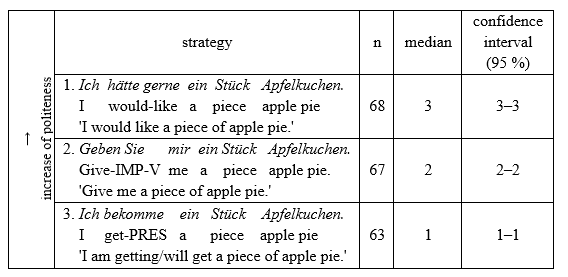
Table 4: Ranking of German requests by Serbian participants.
In the German version of the questionnaire were given only three strategies because the formal equivalent of the Serbian polite future could be excluded as inappropriate or even impolite in advance. Except for the missing strategy, the ranking of the German requests corresponds exactly to the ranking of the Serbian ones. This shows that the Serbian monolingual participants applied the same criteria to the German examples as to the Serbian ones.
The judgements of the 38 German monolingual participants show a slightly different ranking of the German requests:
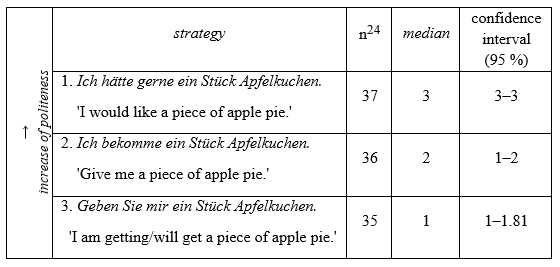
Table 5: Ranking of German requests by German monolinguals.
The German participants also considered the indirect, affirmative strategy using the subjunctive mode as the most polite. However, they ranked the affirmative strategy using the indicative mode more polite than the imperative strategy. This can be interpreted as a hint that strategies of distance are favoured over strategies of directness in German service encounters, and the opposite (at least for the indicative and the imperative strategies) seems to hold for Serbian.
The results of the rankings strengthen the assumption that the Serbian culture is attached to the solidarity cultural paradigm and the German culture to the distance paradigm. It is important to note that the German interviewees rated the strategies according to their frequency of occurrence in the data base (i. e., the most frequently attested requesting formula was rated most polite, etc.). The Serbian interviewees, on the other hand, ranked the most frequently attested strategy in the SC on rank three only. This indicates that the theoretical concepts of politeness in the two cultures do not differ as much as the differences in formal make-up and use of politeness strategies suggests. Politeness as a concept seems to be more associated with politeness of distance than with politeness of solidarity in both cultures.
A strategy of distancing that functions as such in Serbian, but not in German, is the modal future. Here, we must assert that one and the same means can serve quite different, even opposite functions: while in Serbian the future tense serves to produce polite requests, the German future tense pragmatically belongs to the domain of instructions and commands.
As mentioned in the introduction to this paper, it is assumed that the formal makeup of a politeness formula is meaningful in that it conveys information about the politeness system of a cultural community. For instance, an affirmative sentence in the subjunctive mood which focuses on the speaker such as German Ich hätte gerne is obviously more indirect than the corresponding Serbian imperative formula with its focus on the hearer: daj/te mi. Indirectness in the context of requesting can be interpreted as a means of negative politeness. Negative politeness or politeness of distance, as it is labelled here, pays to the negative face wants of the hearer, namely "that his action be unimpeded by others" (Brown/Levinson 1987: 62), thus respecting the hearer's autonomy and self-determination. The makeup of the requesting formulae analysed here allows for the assumption that requesting – at least in the context of service encounters – is considered less face-threatening in the Serbian than in the German culture. This finding is again in line with the solidarity – distance typology which has often been used to describe the differences between Eastern and Western European cultures.
Another interesting difference between Serbian and German exists in the frequency of molim te/Vas (literally: 'I am begging you-T/V') in Serbian and bitte in German. While molim te/Vas occurs only once in a requesting formula in the SC, German bitte stereotypically occurs in requests. This difference may be due to the fact that Serbian molim te/Vas is syntactically more restricted than German bitte. Bitte, originally a first person singular present of the verb bitten ('to ask for'), has lost its arguments and become a particle. Serbian molim te/Vas, on the other hand, usually still functions as a predicate. As such, the transitive verb moliti demands a nominative (usually pro-drop) subject and a direct object in the accusative. This of course makes the Serbian formula less flexible and less convenient than its German counterpart. However, if more frequent use were required, it would well be possible to delete the accusative argument in Serbian, too. 25 The corresponding Czech (prosím) or Polish (proszę) forms substantiate this claim. The less frequent use of please in Serbian may again lead us to the conclusion that it is less important to attenuate the illocutionary force of requests in Serbian than it is in German.26
However, the existence of morphological verbal aspect in Serbian is another factor which can explain the rare use of molim te/Vas as compared to bitte. In Serbian, the perfective aspect occurs in requests by default (cf. Klikovac 1996: 138). The perfective aspect focuses on the verbal action as a whole and is originally designed to refer to singular, completed events. The use of the perfective aspect can thus be interpreted as a mitigating device because it seemingly reduces the impact of the request by not focusing on the requested action itself. Another look at German requesting particles is instructive in this respect. Besides bitte, mal is a particle that occurs regularly in German requests (cf. Hentschel 1991: 141; Schlund 2008: 228–229, 2009: 80–81). The original semantics of mal (literally: 'once') point directly to the semelfactive nature of the perfective aspect. The function of bitte and mal in German thus parallels with the function of the perfective aspect in Serbian.
Nevertheless, it is noteworthy that there were attested written cases of use of molim te/Vas without direct object. Interestingly, they occurred in cash machines, probably as a direct translation of the English version, in which please is almost obligatory:

It may well be that molim will become firmly established as a result of cultural contact (cf. Schlund 2009: 80, 164). The introduction of molim in default requests would entail a development towards the distance pole of our typology.
Although considerable evidence corroborates the solidarity vs. distance hypothesis, there also exist a number of facts challenging it.
As established in Section 2.2, asymmetric forms of address are more common in Serbian than in German. This holds for instance in interactions among people with a great difference in age. In Serbia, it is even common for children-in-law to address their parents-in-law with V and to receive T. This is a very old-fashioned habit in Germany, where parents-in-law and children-in-law nowadays usually receive mutual T (cf. Schlund 2009: 125). The T-address in public orders is another habit that is obsolete in German but still common in Serbian (although it is obviously losing ground against other strategies, see Section 1.2). Furthermore, the mere existence of the V-T differentiation is by far older in German than in Serbian (see Section 2).
The interesting question is why such systematic differences occur. One explanation is offered by an analogy that was originally drawn by Elias (1939/1969) in his famous contribution Über den Prozess der Zivilisation ('On the process of civilization'). Elias argues that politeness standards develop analogically to the general processes of civilization that can be witnessed in all aspects of social life. He points out that, since the Middle Ages, the centres of European civilization have been situated in the West.27 From there they have constantly been spreading towards Eastern Europe. The great difference in age between the two systems of polite address attested in Section 2 also fits into the picture. From this perspective, it becomes understandable why some Serbian politeness standards seem old-fashioned when compared to German ones.
Since the end of the Cold War, Eastern European countries emulate Western countries even more in many domains of socio-cultural life. With the introduction of capitalism, "pragmatic anglicisms" (cf. Mišić Ilić/Lopičić 2011) are entering into Serbian on a large scale. With the rise of internet media, the so-called internationalisation of Serbian (cf. Okuka 2011) increases more than ever. Internationalisation implies a great deal of westernisation. This explains why the Serbian solidarity model of politeness seems to be evolving into a system of more distance in some respects (e. g., the more frequent and pragmaticalized use of molim, the occurrence of deontic infinitives, the spreading of the V-form).
The special situation of Serbia in its recent past also needs to be considered. The severe economic and social conditions under which the Serbian people had to suffer during the 1990s may have left traces in politeness standards, too. It is plausible that an immaterial value such as politeness loses much of its importance when people have to struggle to provide for their everyday needs. Indeed, Jansen reports that a decline in politeness standards took place in the 1990s (cf. Jansen 2005: 149).28 The wars and isolation of the 1990s were favourable to create a strong feeling of togetherness and solidarity among the Serbian people. This may have manifested itself in growing in-group awareness, resulting in the consolidation of solidarity markers (for instance in addressing) and in the need to keep foreigners in a V-V-relationship. The communist past of the Serbia is another factor which was favourable to the emergence of a solidarity culture.
Owing to the limits of a journal article, the empirical findings had to be presented in a very succinct and condensed fashion. Only the most instructive examples could be discussed. With reference to the detailed analysis conducted in Schlund (2009), it is nevertheless justified to claim that most of the differences between Serbian and German linguistic politeness discussed here boil down to the observation that Serbian reflects a culture of solidarity, and German a culture of distance. This corroborates the results of a number of other contributions in which Western and Eastern/South Eastern cultures are compared (e. g., Rathmayr 1996b; Sifianou 1992; Wierzbicka 1985).
On the other hand, there are facts that do not confirm the solidarity vs. distance hypothesis. Most importantly, Serbian sometimes reflects politeness standards which are obsolete in German. To account for such differences, it was assumed that the development of politeness conventions runs parallel with economic and general social developments. This again allows for the prognosis that many Serbian politeness conventions will adapt to Western ones in the future, but not vice versa.
COM commentary
GC German Corpus
KS Katrin Schlund
lit. literally
N N-form of pronominal address (first person plural)
SC Serbian Corpus
T T-form of pronominal address, familiar pronominal address
V V-form of pronominal address, formal pronominal address
Antonopoulou, Eleni/Sifianou, Maria (2005): "Politeness in Greece. The politeness of involvement". In: Hickey, Leo/Stewart, Miranda (eds.): Politeness in Europe. Clevedon etc., Multilingual Matters: 263–276. (= Multilingual Matters 127).
Berger, Tilman (1998): "Äußere Einflüsse und interne Faktoren bei der Herausbildung der slavischen Anredesysteme". Die Welt der Slaven 43: 307–322.
Betsch, Michael (2007): "Anredeformen in den slavischen Sprachen". In: Brehmer, Bernhard/Ždanova, Vladislava/Zimny, Rafał (eds.):Beiträge der Europäischen Slavistischen Linguistik (POLYSLAV) 10. München, Sagner: 11–20. (= Die Welt der Slaven. Sammelbände/ Сборники 29).
Brehmer, Bernhard (2006): "Бери еще огурчик! Diminutiva und Höflichkeit im Russischen". Die Welt der Slaven 51: 23–48.
Brown, Roger/Gilman, Albert (1960): "The pronouns of power and solidarity". In: Sebeok, Thomas A. (ed.): Style in language. Massachusetts, The Technology Press of Massachusetts Institute of Technology: 253–276.
Brown, Penelope/Levinson, Stephen C. (1978): "Universals in language usage. Politeness phenomena". In: Goody, Esther (ed.): Questions and politeness. Strategies in social interaction. Cambridge etc., Cambridge University Press: 253–276.
Brown, Penelope/Levinson, Stephen C. (1987): Politeness. Some universals of language usage. Cambridge: Cambridge University Press.
Department of Linguistics of the Max Planck Institute for Evolutionary Anthropology (eds.): Leipzig Glossing Rules. http://www.eva.mpg.de/lingua/resources/glossing-rules.php, accessed November 18, 2014.
Deppermann, Arnulf (2007): Grammatik und Semantik aus gesprächsanalytischer Sicht. Berlin et al.: de Gruyter. (= Linguistik – Impulse und Tendenzen 14).
Elias, Norbert (1939/1969): Über den Prozess der Zivilisation. Soziogenetische und psychogenetische Untersuchungen. Band I: Wandlungen des Verhaltens in den weltlichen Oberschichten des Abendlandes. Band. II: Wandlungen der Gesellschaft. Entwurf zu einer Theorie der Zivilisation. Zweite, um eine Einleitung vermehrte Auflage. Bern/München: Francke.
Hartmann, Dietrich (1978): "Zum Verhältnis von Sprachgebrauch und Sozialstruktur bei der pronominalen Anrede". In: Quasthoff, Uta (ed.):Sprachstruktur – Sozialstruktur. Zur linguistischen Theoriebildung. Königstein/Taunus, Scriptor: 85–97. (= Monographien Linguistik und Kommunikationswissenschaft 30).
Helmbrecht, Johannes (2005): "Typologie und Diffusion von Höflichkeitspronomina in Europa". Folia Linguistica. Acta Societatis Linguisticae Europaeae 39/3–4: 419–452.
Hentschel, Elke (1991): "Aspect versus particle. Contrasting German and Serbo-Croatian". Multilingua 10/1–2: 139–149.
Jachnow, Helmut (1974): "Zur sozialen Implikation des Gebrauchs von Anredepronomen". Zeitschrift für Slavische Philologie 37: 343–355.
Jansen, Stef (2005): Antinacionalizam. Etnografija otpora u Beogradu i u Zagrebu. Beograd: XX. vek.
Keown, Anne (2003): "Space, size and 'you'. Motivations for Polish pronouns of address". Glossos 4: 1–21. http://slaviccenters.duke.edu/uploads/media_items/4keown.original.pdf, accessed November 18, 2014.
Klikovac, Duška (1996): "O glagolskom vidu u srpskohrvatskom jeziku iz drugog ugla". Zbornik Matice sprske za filologiju i lingvistiku 39/1: 135–139.
Kocher, Margaret (1967): "Second person pronouns in Serbo-Croatian". Language 43/3: 725–741.
Korpus savremenog srpskog jezika na Matemati č nom fakulteta Univerziteta u Beogradu . http://www.korpus.matf.bg.ac.rs/prezentacija/korpus.html, accessed on June 25, 2014.
Lauterbach, Anastassia (1999): Anredeformen im Serbischen um 1800. Die Schauspielbearbeitungen von Joakim Vujić (1772–1847). München: Sagner. (= Slavistische Beiträge 386).
Ličen, Marina (1987): Govorni čin direktiva i njihova jezička realizacija u nemač kom i srpskohrvatskom jeziku. Novi Sad: Filozofski fakultet.
Ličen, Marina (1997): "Govorni čin tipa "zahvalivanje" u nemačkom i srpskom jeziku". Godišnjak Filozofskog fakulteta u Novom Sadu 15: 139–147.
Mendoza, Martha (2005): "Polite diminutives in Spanish. A matter of size?" In: Lakoff, Robin T./Ide, Sachiko (eds.): Broadening the horizon of linguistic politeness. Amsterdam/Philadelphia, Benjamins: 163–173. (= Pragmatics and beyond 139).
Mišeska Tomić, Olga (2006): Balkan Sprachbund morpho-syntactic features. Dordrecht: Springer. (= Studies in Natural Language and Linguistic Theory 67).
Mišić Ilić, Biljana/Lopičić, Vesna (2011): "Pragmatički anglicizmi u srpskom jeziku". Zbornik Matice srpske za filologiju i lingvistiku 54/1: 261–273.
Okuka, Miloš (2011): "Die Internationalisierung des Serbischen". Die Welt der Slaven 56: 384–406.
Rathmayr, Renate (1996a): "Sprachliche Höflichkeit. Am Beispiel expliziter und impliziter Höflichkeit im Russischen". In: Girke, Wolfgang (ed.):Referate des XXI. Konstanzer Slavistischen Arbeitstreffens. Mainz 26.–29.09.1995. München, Sagner: 362–391. (= Slavistische Beiträge 342).
Rathmayr, Renate (1996b): "Höflichkeit als kulturspezifisches Konzept. Russisch im Vergleich". In: Ohnheiser, Ingeborg (ed.): Wechselbeziehungen zwischen slawischen Sprachen, Literaturen und Kulturen in Vergangenheit und Gegenwart. Akten der Tagung aus Anlaß des 25jährigen Bestehens des Instituts für Slawistik an der Universität Innsbruck. Innsbruck, 25.–27. Mai 1995. Innsbruck, Institut für Sprachwissenschaft: 174–185. (= Innsbrucker Beiträge zur Kulturwissenschaft/Slavica aenipontana 4).
Schäfer, Konrad (1951): Entstehung, Entwicklung, Sinn und Bedeutung der Umgangsformen. Wuppertal: Martini & Grüttefien.
Schlund, Katrin (2008): "Motivacije za formulisanje molbi u srpskom i nemačkom jeziku". In: Vanková, Hanna/Příhoda, Marek ( eds.): Slavistika dnes. Vlivy a kontexty (konference maldych slavistů – říjen 2006). Praha, Nakladatelství Pavel Mervart, ve spolupráci s Filozofickou fakultou Univerzity Karlovy v Praze: 223–232.
Schlund, Katrin (2009 ): Genese und Gebrauch von Höflichkeitsformeln im Serbischen und Deutschen. Ein funktionales Modell der Höflichkeit und seine Anwendung. München/Berlin: Sagner. (= Slavistische Beiträge 470).
Schlund, Katrin (2014): "On form and function of politeness formulae". Journal of Politeness Research. Language, behavior, culture 10/2: 271–296.
Sifianou, Maria (1992): Politeness phenomena in England and Greece. A cross-cultural perspective. Oxford: Clarendon Press.
Simon, Horst J. (2003):Für eine grammatische Kategorie "Respekt" im Deutschen. Synchronie, Diachronie und Typologie der deutschen Anredepronomina. Tübingen: Niemeyer. (= Linguistische Arbeiten 474).
Trubeckoj, Nikolaj S. (1931): "Phonologie und Sprachgeographie". Travaux du Cercle linguistique de Prague 4: 228–234.
Watts, Richard J. (2004): Politeness. Cambridge: Cambridge University Press. (= Key topics in sociolinguistics 1).
Wierzbicka, Anna (1985): "Different cultures, different speech acts". Journal of Pragmatics 9: 145–178.
1. Extract from Serbian questionnaire:
1. Odredite sledeće rečenice prema stepenu učtivosti (4 = najučtivije, 1 = najmanje učtivo). Jednu te istu ocenu možete dati više puta. Ako Vam se jedna od rečenica čini neobičnom, molim Vas da je precrtate.
a. Daćete mi pitu sa jabukama. ( )
b. Hteo/htela bih pitu sa jabukama. ( )
c. Dajte mi pitu sa jabukama. ( )
d. Ja ću pitu sa jabukama. ( )
2. Odredite sada na isti način sledeće rečenice (3 = najučtivije, 1 = najmanje učtivo).
a. Geben Sie mir ein Stück Apfelkuchen. ( )
b. Ich hätte gerne ein Stück Apfelkuchen. ( )
c. Ich bekomme ein Stück Apfelkuchen. ( )
□ Ne znam nemački. ('I do not understand German'.)
2. Extract from German questionnaire:
1. Ordnen Sie bitte die folgenden Äußerungen nach dem Grad der Höflichkeit (beginnend mit 1 = am wenigsten höflich bis 3 = am höflichsten). Sie können auch eine Bewertung mehrfach vergeben. Falls Ihnen eine Formulierung unangemessen er-scheint, streichen Sie diese bitte durch.
a. Geben Sie mir ein Stück Apfelkuchen. ( )
b. Ich hätte gerne ein Stück Apfelkuchen. ( )
c. Ich bekomme ein Stück Apfelkuchen. ( )
2. Ordnen Sie nun auf die gleiche Weise die folgenden serbischen Äußerungen nach dem Grad der Höflichkeit (diesmal von 1 = am wenigsten höflich bis 4 = am höflichsten).
a. Daćete mi pitu sa jabukama. ( )
b. Hteo/htela bih pitu sa jabukama. ( )
c. Dajte mi pitu sa jabukama. ( )
d. Ja ću pitu sa jabukama. ( )
□ Ich verstehe kein Serbisch. ('I do not understand Serbian.')
Translation:
Please rank the following sentences according to their degree of politeness (starting with 1 = least polite till 4 = most polite). You may make the same assessment more than once. In case one of the formulations appears inappropriate to you, you can cross it out.
1 This article outlines the most important findings of an empirical study on linguistic politeness in Serbian and German. To view the results in full length, please consult Schlund (2009). back
2 For the sake of readability, the author will henceforth refer to German norms of politeness only. I am well aware of the fact that there may be differences between Western and Eastern German politeness phenomena. back
3 To my knowledge, the only comparative studies of linguistic politeness in Serbian and German have been conducted by Ličen (1987, 1997). These are, however, not based on empirical data. back
4 Minimal conversations only, excluding, of course, commentaries and meta-linguistic information. back
5 The corpora are published in full length in Schlund (2009). back
6 For instance Sifianou (1992) for English and Greek, Wierzbicka (1985) for English and Polish, or Rathmayr (1996b) for German and Russian. back
7 The labels are derived from Rathmayr's (1996a) distinction between Solidaritätshöflichkeit ('politeness of solidarity') and Distanzhöflichkeit ('politeness of distance'). Rathmayr's terms correspond to Brown's and Levinson's (1978, 1987) famous distinction between positive and negative politeness (cf. Rathmayr 1996a: 376). back
8 Familiar pronominal address will henceforth be referred to as T(-form); the formal pronominal address will be referred to as V(-form). back
9 It is not possible here to discuss the semantic nuances that existed between the three forms of formal address. Interested readers are referred to Simon (2003: 92–133) and Helmbrecht (2005: 436–438). back
10 Except for Slovenian and Croatian, which in the case of address systems belong to the western rather than the southern group of Slavic languages (cf. Betsch 2007: 17). back
11 This is, however, not true for Serbian settlement areas within the Habsburg Monarchy, where the formal address was introduced much earlier due to the Austro-Hungarian influence (cf. Lauterbach 1999). back
12 The interlinear glosses given in the examples follow the Leipzig Glossing Rules (www.eva.mpg.de/lingua/resources/glossing-rules.php) but are kept to a minimum in order to facilitate legibility. back
13 Just like Serbian izvoli/izvolite, bitte schön corresponds to either what would you like (at the beginning of a service encounter) or to here you are (at the end of a service encounter). back
14 Ajvar is a kind of spread or side dish made of sweet peppers and other vegetables. It can be either spicy (hot avjar) or mild (sweet ajvar). back
15 N according to Latin nos ‘we'. back
16 I owe thanks to an anonymous reviewer for this remark. back
17 This is astonishingly in line with the results presented in Section 3, which suggest that Serbian prefers hearer-oriented requesting strategies and German speaker-oriented ones. Of course, much more data is needed to verify this observation. back
18 I owe thanks to an anonymous reviewer for this remark. back
19 See Section 3.3 for that matter. back
20 The participants were either native speakers of Serbian, German or bilingual speakers of both languages. As the main part of the survey was conducted at universities, most of the participants were students aged between 19 and 25. back
21 The exact wording of the questionnaire is given in the appendix to this paper. back
22 Monolingual in our contexts means that the participants had given either German or Serbian as their native language, not both, and that they had spent no more than one year in Serbian- or German-speaking countries. back
23 Four Serbian participants classified themselves as bilinguals of Serbian and German. To make sure that the ranking shows monolingual Serbian evaluations, the rankings of the bilinguals were not included in Table 3. back
24 One of the 38 German monolinguals did not do the ranking task at all without giving any reasons for this. back
25 Molim without te/Vas can actually be attested in contexts of requesting in the Serbian National Corpus ( www.korpus.matf.bg.ac.rs/prezentacija/korpus.html). However, due to native speaker informants, bare molim in a request sounds somewhat odd. In any case, neither use of molim (be it with or without the object) occurs by default in regular requests. back
26 The less frequent use of molim te /Vas as compared to bitte is intensely discussed in the expert interview (cf. Schlund 2009: 122–123). back
27 There have of course been centres of civilisation in Eastern and South Eastern Europe as well (e. g., Byzantium, Kiev, Novgorod) but those were all non-continuous phenomena, interrupted by invasions or other developments. back
28 The decline of politeness standards in the 1990s is purported in the expert interview as well (cf. Schlund 2009: 119). back